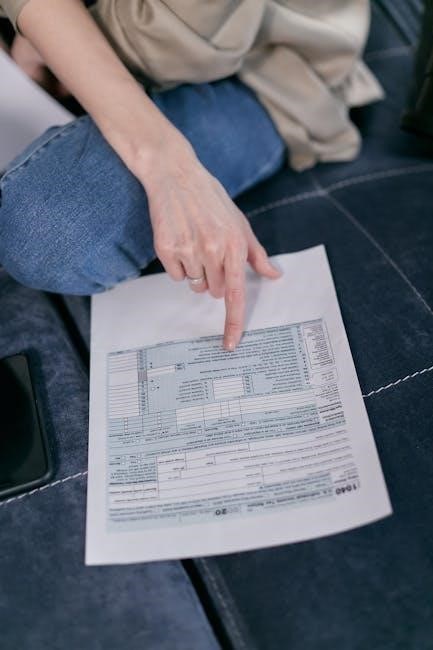Form 8915-F is a forever form introduced by the IRS for reporting qualified disaster distributions and repayments from retirement plans‚ including COVID-19-related withdrawals. It simplifies tax reporting for affected individuals.
Background and Purpose
Form 8915-F was introduced by the IRS to address the financial impact of qualified disasters‚ including COVID-19. Its primary purpose is to provide a standardized method for taxpayers to report distributions from retirement plans and any subsequent repayments. This form aims to simplify tax reporting for individuals affected by such events‚ ensuring compliance with IRS regulations while offering potential tax relief.
Overview of the Form
Form 8915-F is a forever form used annually to report qualified disaster distributions and repayments from retirement plans. It applies to COVID-19-related withdrawals and other federally declared disasters. The form includes a $22‚000 limit per disaster for 2021 and later years. It provides a structured format for detailing distributions‚ repayments‚ and tax implications‚ ensuring accurate reporting and compliance with IRS guidelines. Taxpayers use it to account for retirement plan withdrawals due to eligible disasters.

Eligibility Criteria
Eligibility for Form 8915-F is based on being affected by a qualified disaster‚ such as COVID-19 or federally declared disasters‚ and involves retirement plan distributions or repayments.
Who Can Use Form 8915-F
Form 8915-F is designed for individuals impacted by qualified disasters‚ including COVID-19‚ who took distributions from retirement plans. It applies to those affected by federally declared disasters starting in 2020. Eligibility extends to taxpayers who received qualified disaster distributions or repaid such amounts. The form is specifically for reporting these transactions and claiming related tax benefits. It is not applicable to non-disaster related withdrawals or distributions; Proper documentation and meeting IRS criteria are essential for eligibility.
Qualifying Reasons for Distribution
Qualifying reasons for using Form 8915-F include distributions due to COVID-19 or federally declared disasters starting in 2020. These distributions must be from qualified retirement plans and linked to the adverse impact of the disaster. The IRS specifies that the distribution must be directly related to the disaster or its aftermath. Additionally‚ the taxpayer must have been affected by the disaster‚ such as experiencing financial hardship or loss due to the event. Proper documentation of the disaster’s impact is required.

Key Features of Form 8915-F
Form 8915-F is a forever form‚ meaning it remains applicable yearly. It’s used for reporting distributions and repayments tied to qualified disasters starting from COVID-19 in 2020.
Forever Form Status
Form 8915-F is designated as a “forever form‚” meaning it remains in use annually without annual updates for each disaster. This streamlines reporting for taxpayers affected by qualified disasters‚ ensuring consistent filing processes. The IRS introduced this status to reduce administrative burdens‚ allowing taxpayers to focus on recovery rather than form changes. It applies to distributions from retirement plans due to COVID-19 and subsequent disasters‚ starting in 2020.
Annual Use for Different Disasters
Form 8915-F is designed for annual use‚ accommodating distributions from retirement plans due to qualified disasters‚ including COVID-19. Taxpayers affected by presidentially declared disasters can report distributions and repayments yearly. The form applies to multiple disasters‚ ensuring flexibility for filers impacted by various events. For 2021 and later disasters‚ a $22‚000 limit per disaster applies‚ aligning with IRS guidelines. This annual use ensures consistent reporting without requiring new forms for each disaster‚ enhancing efficiency for taxpayers.
Specific Rules and Limits
Form 8915-F has specific rules‚ including a $22‚000 limit for qualified disaster distributions per disaster in 2021 and later. This limit applies to each disaster‚ allowing multiple claims if affected by several events. Repayment options are available‚ with three years to recontribute funds without penalty. Additionally‚ income inclusion can be spread over three years‚ reducing immediate tax liability. These rules ensure fair tax treatment for disaster-affected taxpayers while maintaining compliance with IRS regulations. Proper documentation is essential to meet these criteria.

When to Use Form 8915-F
Form 8915-F is used to report qualified disaster retirement plan distributions and repayments‚ specifically for COVID-19-related distributions in 2020 and qualified disasters occurring in 2021 and later years.
Filing Deadlines
Form 8915-F must be filed by the standard tax filing deadline‚ typically April 15th‚ or by the extended deadline of October 15th if an extension is requested. Deadlines may vary based on the specific disaster scenario. Taxpayers affected by qualified disasters should ensure timely submission to meet IRS requirements and avoid penalties. The form allows for reporting distributions and repayments within the designated periods‚ ensuring compliance with federal tax regulations.
Applicable Disaster Scenarios
Form 8915-F applies to distributions related to qualified disasters declared by the President‚ such as hurricanes‚ wildfires‚ and the COVID-19 pandemic. It covers distributions made in 2020 and later years for specified disasters. Taxpayers affected by these events can use the form to report withdrawals from retirement plans. The IRS updates the list of eligible disasters annually‚ ensuring the form remains relevant for current and future events.

How to Use Form 8915-F
Use Form 8915-F to report qualified disaster distributions and repayments. Follow IRS instructions to determine eligibility‚ calculate amounts‚ and attach required documentation for accurate filing.
Step-by-Step Completion Guide
Determine eligibility based on qualified disasters or COVID-19 impacts.
Gather documents like retirement plan statements and disaster declarations.
Complete Part I for distributions and Part II for repayments.
Calculate taxable amounts using the provided worksheets.
Attach supporting documents and submit with your tax return.
Ensure accuracy to avoid delays or penalties.
Required Documentation
Ensure you have proof of qualified disaster impact‚ retirement plan statements‚ and records of distributions or repayments. Attach Form 8915-F to your tax return‚ including any IRS declarations of disaster. Keep copies of all documents for at least three years. Proper documentation ensures compliance and avoids delays in processing.

Tax Implications
Form 8915-F treats qualified disaster distributions as taxable income unless repaid. Repayment within three years may reduce taxes owed. Failure to repay includes amounts in taxable income‚ potentially incurring penalties.
Income Inclusion Rules
Qualified disaster distributions reported on Form 8915-F are generally taxable and must be included in taxable income for the year received‚ unless repaid. Repayment within three years may reduce taxable income. If repayment is not made‚ the distribution is included in income‚ potentially leading to additional taxes owed. The IRS allows recontribution to retirement plans to avoid immediate taxation‚ providing flexibility for affected taxpayers to manage their tax obligations effectively over time.
Repayment and Tax Benefits
Repayment of qualified disaster distributions within three years can reduce taxable income and provide tax benefits. Taxpayers who repay distributions avoid including the amount in income‚ potentially reducing their tax liability. Repayment also allows recontribution to retirement plans‚ maintaining retirement savings. The IRS offers flexibility to manage tax obligations effectively‚ ensuring affected individuals can recover financially while adhering to tax rules and avoiding penalties associated with early withdrawals.
Penalties and Exemptions
Form 8915-F helps taxpayers avoid penalties for early retirement distributions due to qualified disasters. Typically‚ a 10% penalty applies to withdrawals before age 59½‚ but exemptions exist for disaster-related distributions. Taxpayers must meet specific criteria to qualify for penalty exemptions. The IRS allows up to $2‚000 of distributions to be exempt from income inclusion‚ reducing tax liability. Proper documentation and adherence to IRS guidelines are essential to ensure compliance and avoid penalties associated with early withdrawals.

Repayment and Recontribution
Repayment and recontribution options allow taxpayers to return distributed funds within three years‚ avoiding taxes and penalties. Recontribution benefits include tax-free rollovers and restored retirement savings.
Repayment Process
The repayment process for distributions reported on Form 8915-F involves returning funds to a qualified retirement account within three years. Taxpayers can recontribute amounts to avoid income inclusion and potential penalties. The IRS allows for tax-free rollovers‚ provided repayments adhere to specific rules. Annual reporting is required to track repayments‚ ensuring compliance with tax obligations. Proper documentation and adherence to IRS instructions are essential for a smooth repayment process.
Benefits of Recontribution
Recontributing distributions reported on Form 8915-F offers significant tax benefits. By returning funds to a retirement account‚ individuals avoid paying income tax on the distribution. Additionally‚ recontribution restores retirement savings‚ ensuring long-term financial security. The IRS allows tax-free rollovers‚ eliminating penalties and interest that would otherwise apply. This option provides flexibility and financial relief‚ helping taxpayers recover from disaster-related hardships without long-term tax consequences.

Documentation Requirements
Retain records of retirement distributions‚ repayment plans‚ and disaster-related documentation. Maintain detailed records to support your filings and ensure compliance with IRS verification processes.
Necessary Documents
To complete Form 8915-F‚ retain records of retirement plan distributions‚ repayment schedules‚ and proof of disaster impact. Include bank statements‚ distribution notices‚ and written repayment plans. Maintain documentation showing the disaster’s effect on your ability to repay. Keep records of any COVID-19-related hardship withdrawals. Ensure all documents are dated and clearly tied to the disaster or hardship. Proper documentation supports compliance with IRS requirements and avoids potential disputes. Failure to maintain these records may lead to delays or issues in processing your form.
Record Keeping Tips
Organize all documents related to your retirement distributions and repayments in a secure‚ easily accessible location. Digitally backup records to prevent loss. Store physical copies in a fireproof safe or secure storage. Keep detailed notes of all transactions‚ including dates and amounts. Maintain records for at least six years after filing‚ as recommended by the IRS. Regularly review and update your records to ensure accuracy. This helps in case of an audit or if additional information is needed for future filings.
Comparison with Other IRS Forms
Form 8915-F is a forever form‚ replacing earlier 8915 series. It specifically addresses qualified disaster and COVID-19 distributions‚ consolidating reporting for affected taxpayers annually.
Differences from Form 8915
Form 8915-F is a “forever form‚” replacing earlier versions like Form 8915. It specifically addresses qualified disaster distributions‚ including COVID-19-related withdrawals‚ and is used annually for different disasters. Unlike Form 8915‚ it eliminates the need for yearly alphabetical updates‚ providing a permanent solution for reporting such distributions. The $22‚000 limit per disaster applies‚ making it distinct from prior forms.
Understanding Form Selection
Selecting the correct IRS form is crucial for accurate tax reporting; Form 8915-F is specifically designed for reporting qualified disaster distributions and repayments‚ including COVID-19-related withdrawals. Unlike other forms‚ it caters to withdrawals due to federally declared disasters or the pandemic‚ ensuring proper tax treatment. Understanding which form to use helps avoid errors and ensures compliance with IRS guidelines for retirement plan distributions and repayments.

Dollar Limit Per Disaster
Form 8915-F sets a $22‚000 limit per qualified disaster for retirement distributions in 2021 and later years‚ aiding taxpayers affected by disasters.
2021 and Later Disasters
For disasters occurring in 2021 and later years‚ Form 8915-F limits qualified retirement distributions to $22‚000 per disaster. This cap applies to each qualified disaster declared by the President‚ providing relief to affected taxpayers. The IRS established this limit to ensure consistent reporting and tax treatment for disaster-related withdrawals. Taxpayers must use Form 8915-F to report these distributions and any repayments‚ adhering to specific guidelines outlined in the form’s instructions. This rule helps streamline the tax filing process for individuals impacted by recent disasters‚ offering clarity and standardized reporting requirements. The $22‚000 limit per disaster remains unchanged for subsequent years unless amended by the IRS. By adhering to this cap‚ taxpayers can ensure compliance with current tax regulations and avoid potential penalties or delays in processing their returns. Proper documentation and accurate reporting are essential to meet the IRS requirements for disaster-related distributions.
Specific Figures and Adjustments
For qualified disasters in 2021 and later‚ the IRS sets a $22‚000 limit per disaster for retirement plan distributions reported on Form 8915-F. This cap applies to each disaster declared by the President‚ ensuring consistent reporting. The IRS established this figure to provide uniform tax treatment for disaster-related withdrawals. The $22‚000 limit remains unchanged annually unless amended. Taxpayers must adhere to this amount for accurate reporting and compliance with IRS regulations. Adjustments‚ if any‚ are announced by the IRS to reflect economic changes or legislative updates.

Recent IRS Updates
The IRS updated Form 8915-F instructions in 2023‚ clarifying the $22‚000 limit for 2021 disasters and confirming no additional Forms 8915 will be issued.
Latest Instructions and Changes
The IRS has updated Form 8915-F instructions to reflect the $22‚000 limit for qualified 2021 and later disasters. This adjustment ensures clarity for taxpayers reporting distributions. Additionally‚ the IRS confirmed that no new Forms 8915 will be issued‚ making Form 8915-F a permanent solution for disaster-related distributions. These changes simplify the filing process and provide consistent guidelines for affected individuals. The updates are available on IRS.gov for reference.
Impact on Current Filings
Form 8915-F streamlines reporting for qualified disaster distributions‚ reducing administrative burdens. The $22‚000 limit for 2021 and later disasters provides clarity for current filers. As a forever form‚ it eliminates the need for annual updates‚ ensuring consistency. Taxpayers can confidently use this form for future disasters‚ knowing the guidelines remain stable. This stability simplifies compliance and reduces confusion‚ benefiting filers affected by recent or ongoing disasters.
Final Thoughts
Form 8915-F is a vital tool for taxpayers affected by qualified disasters‚ offering streamlined reporting for retirement plan distributions. Its forever form status ensures consistency‚ while its specific rules provide clarity. Understanding the form’s requirements and benefits is essential for maximizing tax relief and avoiding penalties. By adhering to IRS guidelines and seeking professional advice if needed‚ filers can navigate the process confidently and ensure compliance with all regulations.
Best Practices for Filing
Always consult the latest IRS instructions for Form 8915-F to ensure compliance. Verify eligibility and understand the specific rules for your situation. Keep detailed records of distributions and repayments‚ and seek professional advice if unsure. Double-check calculations to avoid errors. File timely and maintain documentation for audits. Leveraging IRS resources and staying informed about updates can streamline the process and prevent potential penalties. Accurate and timely filing ensures optimal tax relief.


